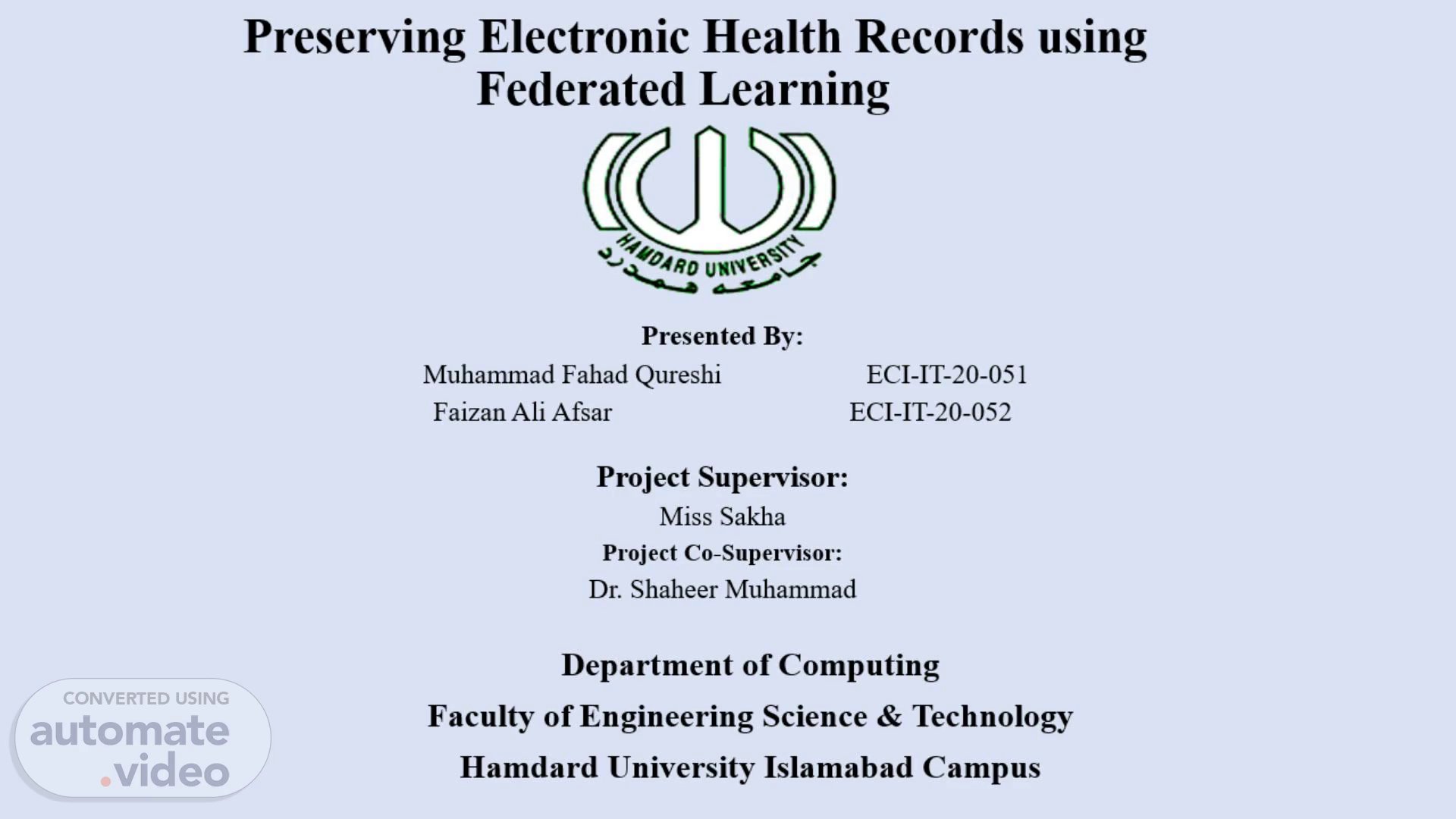
Preserving Electronic Health Records using Federated Learning
Scene 1 (0s)
[Audio] Preserving Electronic Health Records using Federated Learning Presented By: Muhammad Fahad Qureshi ECI-IT-20-051 Faizan Ali Afsar ECI-IT-20-052 Project Supervisor: Miss Sakha Project Co-Supervisor: Dr. Shaheer Muhammad Department of Computing Faculty of Engineering Science & Technology Hamdard University Islamabad Campus.
Scene 2 (14s)
[Audio] Introduction(1/2) Electronic Health Records (EHRs): Electronic Healthcare Record (EHR) systems were introduced to store patient records electronically in a database so that they could be accessed from anywhere and by anyone, with granted access, using the Internet. Data Breaching in EHRs: A data breach happens when unauthorized individuals or entities access sensitive and private data cloud user , which result in the theft of private data. Data breaches in electronic health records happens when someone unauthorized access to sensitive patient information stored in cloud. such as weak passwords, outdated software, or lack of encryption. Employees at healthcare organizations can access and leak information about patients accidentally or for some other purpose, This can lead to breaches. Maintaining Security and Privacy of Electronic Health Records using Federated Learning on Cloud.
Scene 3 (19s)
[Audio] Introduction(2/2) Security and privacy Security and privacy are two crucial issues in the protection of health information. The purpose is to keep the medical privacy of confidential information about the patient. Privacy: How you allow your personal information to be accessed and viewed. Security :Protection of your private data and information. The main difference between privacy and security is that privacy involves how your data is used and controlled, while security protects this data. Federated Learning Federated learning is a distributed machine learning that enables machine learning models to be trained on decentralized data sources without compromising privacy or security. This allows the server to aggregate the models and update the global model while preserving the privacy and security of the data. Maintaining Security and Privacy of Electronic Health Records using Federated Learning on Cloud by allowing multiple parties to train models on their local data while sharing the learned parameters with the central serve.
Scene 4 (31s)
[Audio] Aims & Objectives Aim: The aim is study to introduce the methods for determining the data leaks and implements state of the art data privacy and security technique. Objectives: Preserving Patient Privacy One of the primary objectives of implementing Federated Learning in electronic health records (EHR) is to enhance and safeguard patient privacy. Securing Sensitive Health Care Data. The security of electronic health records is crucial to prevent unauthorized access and protect patient confidentiality..
Scene 5 (41s)
[Audio] Problem Statement The EHR system faces significant security and privacy challenges, risking sensitive patient data exposure. The existing EHR systems lack in security measures, posing a serious threat to patient data confidentiality. Federating learning is distributed Machine learning model can be implemented on decentralized data sources However implementation of Federated learning can be challenge..
Scene 6 (49s)
[Audio] Project Scope This project's scope includes the design and implementation of security and privacy features in Electronic Health Record (EHR) systems using federated learning. It encompasses the development of a federated learning model, integration with existing EHR infrastructure, and compliance with healthcare data protection regulation as per HIPAA. e Health Insurance Portability and Accountability Act of 1996 (HIPAA) was signed by President Clinton on July 21, 1996 and has the general objectives to · Guarantee health insurance coverage of employees. · Reduce health care fraud and abuse. · Introduce/implement administrative simplifications in order to augment effectiveness and efficiency of the health care system in the United States. · Protect the health information of individuals against access without consent or authorization..